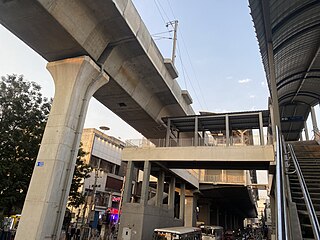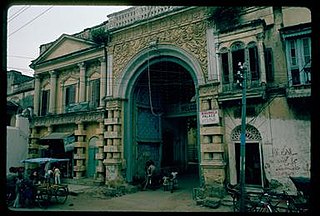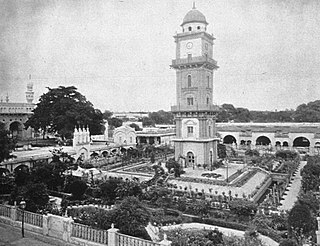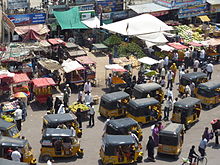
The Charminar is a monument located in Hyderabad, Telangana, India. Constructed in 1591, the landmark is a symbol of Hyderabad and officially incorporated in the emblem of Telangana. The Charminar's long history includes the existence of a mosque on its top floor for more than 425 years. While both historically and religiously significant, it is also known for its popular and busy local markets surrounding the structure, and has become one of the most frequented tourist attractions in Hyderabad. Charminar is also a site of numerous festival celebrations, such as Eid-ul-adha and Eid al-Fitr, as it is adjacent to the city's main mosque, the Makkah Masjid.
Bangles are traditionally rigid bracelets which are usually made of metal, wood, glass or plastic. These ornaments are worn mostly by women in the Indian subcontinent, Southeastern Asia, the Arabian Peninsula, and Africa. It is common to see a bride wearing glass bangles at weddings in India, Bangladesh, Pakistan, Nepal, Sri Lanka and in other Asian countries. Bangles may also be worn by young girls, and bangles made of gold or silver are preferred for toddlers. Some men and women wear a single bangle on the arm or wrist called kada or kara.

Sultan Bazar is an old commercial market in Hyderabad, Telangana, India. It lies between the commercial areas of Abids and Koti. It was previously known as the residency bazaar. Later it was named after the nawab of that area, Syed Sultanuddin, and so is known as sultan bazar now.

Malwala Palace was built in 1845 and is located in Hyderabad, telangana, India. Malwala Palace was located along the road leading towards east from Charminar. It was constructed in Mughal and Rajasthani style and in Hyderabadi courtyard style, was known for its richly carved. wooden pavilion. Other than Raja Bhagwandas Bagh Pavilion, Malwala Palace was the only other palace in Hyderabad having a wooden pavilion. Barring the grand gateway, the entire palace complex has been demolished in August 2000 and a shopping mall has been built in its place.

Dewan Devdi was the palace of the nobles, the Salar Jungs, situated close to Charminar and Chowmahalla Palace in Hyderabad, India. The word Diwan means Prime Minister, and Devdi refers to mansions of Hyderabadi noblemen.

Hyderabad is located in central Telangana and is spread over an area of 2,500 km2. The city lies in the Deccan Plateau and rises to an average height of 536 m above the sea level. The city lies at 17.366° N latitude and 78.476° E longitude.
Yakutpura is a traditional neighbourhoods in the Old City, Hyderabad in Telangana state, India. With a population of 6,3350 inhabitants, the size of the area is about 5.7 square kilometers.
Dabeerpura is one of the oldest neighborhoods in the Old City area of Hyderabad, Telangana, India. It is surrounded by Yakutpura, Chanchalguda, Purani Haveli, Noorkhan Bazar, and Azampura. Dabeerpura has one of the original thirteen gateways called darwaza.
Edi Bazar is the oldest market place of Hyderabad, in Telangana state, India.

Madina building is Waqf property aimed to serve Hajj pilgrims built by the 7th Nizam of Hyderabad Deccan.
Begum Bazaar is the biggest commercial market in Hyderabad, India. It was established during the Qutb Shahi rule. Begum Bazaar is located about a half of a kilometer from the Naya Pul bridge in the Old City. It is an old retail and wholesale market for household commodities. Several popular brassware merchants and copper brassware traders are based here. The bazaar is also known for its congestion and heavy traffic. It is also famous for spices and the markets nearby Charminar, a historic monument.
Afzal Gunj is one of the neighbourhoods located on the border of central Hyderabad and the Old City, Hyderabad, Telangana, India, close to river Musi. Afzal Gunj is the hub of local transportation due to the presence of Central Bus Station in the region. The bus station provides services to most parts of the city.

The Old City of Hyderabad is a walled city of Hyderabad, Telangana, India, located on the banks of the Musi River built by Qutb Shahi sultan Muhammed Quli Qutb Shah in 1591 AD. There used to be a wall surrounding the Old City, most of which is destroyed. Mubariz Khan, the Mughal governor of Deccan Subah, had fortified the city in 1712 and was completed by Nizam of Hyderabad.

Shahran Market, also known as Shahran Bazaar, is located in Hyderabad, India near Charminar and Laad Bazaar.
Chatta Bazaar, is located in Hyderabad, India. Chatta Bazar is one of the oldest bazaars in Hyderabad and was the first to organize shops under a roof for better storage of goods.

The culture of Hyderabad, also known as Hyderabadi Tehzeeb or Dakhini Tehzeeb, is the traditional cultural lifestyle of the Hyderabadi Muslims, and characterizes distinct linguistic and cultural traditions of North and South India, which meet and mingle in the city and erstwhile kingdom. This blending was the result of the geographic location of the region and the variety of historical dynasties that ruled the city across different periods—its inception by the Qutub Shahi dynasty in 1591 AD, the occupation by the Mughal Empire and its decline, and the patronage under the Asaf Jahi dynasty.

Mahboob Chowk Clock Tower is a five-storied architectural clock tower which was built in 1892 by Asman Jah, Prime Minister of Hyderabad. Named after the 6th Nizam of Hyderabad -, the Mahboob Chowk area is considered to be an important part architectural heritage of Hyderabad.
The localities and neighborhoods of Hyderabad have unique oral histories, dating to the time of the Qutb Shahi dynasty, over 400 years ago, and are named after various people and things. Some are named after a major building or structure in the locality, others named for individuals. The names are mostly in Telugu and Urdu, the major languages of the city. This is a list of localities, neighborhoods and streets of Hyderabad and their etymology.

A distinct Indo-Islamic architecture style with local contribution is reflected in the historical buildings of Hyderabad, making it the first and "Best Heritage City of India" as of March 2012. The city houses many famous historical sites constructed during Qutb Shahi and Asaf Jahi period, including various mosques and palaces.















